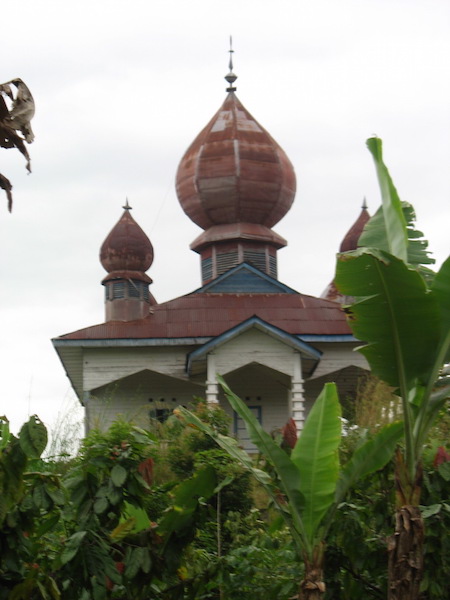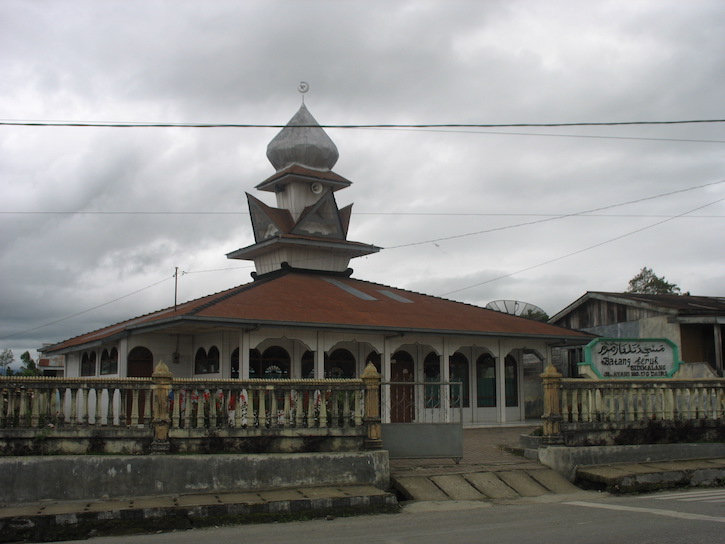Aceh Singkil’s recent church burning may reflect common ways Indonesians have linked religion and region
Daniel Andrew Birchok
On 13 October 2015, a group of Muslim residents in the district of Aceh Singkil burned down a Christian church, then attempted to do the same to a second. The attackers allegedly claimed to be acting to close illegal houses of worship, that is, churches without government permits. One member of the group died after clashing with police. In the aftermath, the local government closed ten other churches thought not to have proper permits, and several thousand Christians fled across Aceh’s border with North Sumatra.
Reading news stories about these tragic events, I was struck by a sense of déjà vu. In 2008 and 2009, I conducted research in the archives of the Acehnese branch of the Indonesian Council of Ulama, located in Banda Aceh. Among these files is a collection of documents related to an earlier period of tensions between Muslims and Christians in Aceh Singkil.
Between 1968 and 1979 the question of churches without proper permits led to similar confrontations in this region. In March 1978, these tensions climaxed when four churches were burned by an Acehnese mob. At least one man, in this case a Christian, died. A second round of church burnings occurred in June 1979. After these, the national government helped to negotiate an agreement to end the violence. As in 2015, this settlement entailed the closing of churches without government permits.
Recent news coverage
News coverage of the recent church burning in Aceh Singkil has virtually ignored this history of interreligious tensions. This is despite the fact that at least one prominent Indonesian human rights organisation, the Setara Institute, has raised the legacy of interreligious tensions in the region, and that similar incidents also occurred in 2001 and 2012.
English-language media coverage has instead focused on Aceh’s status as a ‘conservative’ Islamic province, blaming the violence on Aceh’s Islamic legal reforms or an allegedly growing religious conservatism in Indonesia more generally. Indonesian media and politicians, for their part, have repeatedly focused on ‘provocateurs,’ suggesting that the violence is the result of a small group of trouble makers.
There is some truth in both of these explanations. For example, it appears that the radical group Islamic Defenders Front helped to mobilise the attacks. Nonetheless, these explanations fail to consider the longer history of similar incidents in this region. Considering this history gives a more complete picture of what has driven interreligious tensions in Aceh Singkil, and how these tensions are part of broader patterns in Indonesia.
Tensions in the 1970s
According to the files in the archive of the Acehnese branch of the Indonesian Council of Ulama, in the 1970s most Christians in Aceh Singkil were Karo and Toba Batak migrants who had come to Aceh from adjacent North Sumatra to work on palm oil plantations.
The perception that large numbers of Christians were crossing into Aceh, whether accurate or not, created a great deal of anxiety for some Acehnese. One report, submitted by a group from Aceh Singkil in the aftermath of the 1978 incidents, describes Karo and Toba Batak migrants as ‘wildly coming across the Acehnese border.’ It blames the church burnings on the provincial government for failing to stop this flow of Christian migrants. Its alarmist tone is shared by other documents in the file.
Why would migration across this provincial border provoke such anxiety?
In 1951, Aceh was absorbed into the province of North Sumatra. Many Acehnese resented this. Acehnese politicians and newspaper dispatches regularly focused on the question of the dissolved border between Aceh and North Sumatra. By the time the border between the two provinces was reinstated in 1957, it had become a focal point of public concern. Today, many Acehnese still recall this episode as part of a long history of abuse at the hands of the central government.
Intensifying this concern for some Acehnese was the perceived threat of Christian missionaries entering Aceh along with economic migrants. The aforementioned 1978 report referenced multiple cases of such covert missionising. In fact, the provincial Council of Ulama had responded to earlier accusations of this kind from 1975, by proposing what it called ‘faith immunisations’, that is, the dispatching of a special corps of Islamic teachers to counteract Christian influences.
A nation divided?
Anxieties regarding the Aceh-North Sumatra border, together with the fears some Acehnese held regarding Christian missionary activity, are an important starting point for any explanation of Muslim-Christian tensions in Aceh Singkil. One other pattern apparent in the documents about the 1978 and 1979 episodes provides further clarity.
Several of the letters and reports in the Council of Ulama’s archival file describe the problem in nationalist terms. They do so in a very specific way. In describing the Indonesian nation, they identify it as a place in which Muslims and Christians each have their own place, and should stay in it.
In one letter, a group of self-identified Muslim citizens from Aceh Singkil complain about the number of Christians moving to ‘Mecca’s Veranda,’ a common nickname for Aceh that draws attention to the region’s reputation as the first Indonesian province to have accepted Islam. Another document notes that migrants were coming from ‘an area in which Christians already have advantages,’ namely, North Sumatra. These kinds of statements, which are found repeatedly in the documents, identify Aceh as a territory for Muslims, and North Sumatra as a territory for Christians.
This way of understanding the nation, with different provinces or regions being the proper places of specific religious groups, remains common today. An Acehnese friend once told me that his Christian acquaintances should not be allowed to build a church in Aceh, because ‘they already have a place to build a church. North Sumatra!’
Such attitudes are not limited to Acehnese. Elsewhere in the archipelago, people regularly identify Aceh as a Muslim province, Bali as a Hindu province, North Sulawesi as a Christian province, and so on. These are not simply descriptive claims, but often are normative statements about what kinds of people and religions should exist in a particular territory.
Such thinking goes back to the colonial period, when Dutch officials assigned different religions to different regions. They forbade Christian missionary activity amongst Muslims, and restricted Christian missions of different denominations to different territories.
This way of thinking continues to be reflected, in a modified form, in the process through which Indonesians receive permits to build houses of worship.

The building of houses of worship is governed nationally by a 2006 regulation (PBM 9 and 8/2006), and in Aceh by a 2007 law (Pergub 25/2007). While in principle proclaiming religious freedom, in practice these regulations grant religious rights in a territorially-based manner. They make the demographics of a region the practical legal ground on which a permit for a house of worship is to be granted. For example, if there are not a minimum number of Christians living in a legally-defined jurisdiction, or if too many of their presumably non-Christian neighbours refuse to grant their consent to a new church, then they cannot receive a permit. The rules apply to mosques in predominantly Christian areas as well.
In the event that not enough neighbours give their consent to a new house of worship, the regulations do require local governments to facilitate the finding of an appropriate location. They can also issue temporary permits so that worshipers can use ordinary buildings for religious purposes. But finding a new location or issuing temporary permits can prove difficult when the explicit regulatory framework for permitting a house of worship is so closely tied to the demographics of a region, especially when the neighbours of a previously proposed building have already rejected it.
When coupled with histories of interreligious tensions such as those found in Aceh Singkil, these regulations can amplify already existing sentiments that some territories belong to one religious group, while other territories belong to a different one.
Without more detailed research of the recent October church burning, it is impossible to say for sure if such a sentiment motivated the attackers. But press reports have noted that perpetrators justified their actions by arguing that the allegedly illegal churches violated the agreement that ended the violence of the 1970s. This at least suggests that those who partook in this church burning understood their actions in light of these earlier tensions, which many Acehnese expressed in terms of keeping Muslims and Christians in their respective places.
What the future holds
In the 1970s, anti-Christian violence in Aceh Singkil was driven by local concerns about the integrity of the Acehnese border, the perceived threat of secret Christian missions, and ideas about where Muslims and Christians properly belong.
It is not yet clear which, if any, of these factors influenced the recent October episode. However, considering the October church burning in view of this longer history should cause one pause when encountering explanations of the violence that emphasise increasing religious conservatism or the work of provocateurs. These factors may be elements in the latest chapter of this tragic history, but it is unlikely that they are the whole story.
Unfortunately, it is also unlikely that the handling of the October events will prevent future episodes of violence. Local government actions have left the status quo in place, closing churches that have been unable to secure permits under the current legal framework.
Ultimately, as the Setara Institute has pointed out, it will only be when the Indonesian government moves to protect the religious rights of Aceh Singkil’s Christians that the foundations for a lasting peace will be laid. Among other things, this will require Indonesians to rethink common assumptions about the relationship between religion and region.
Daniel Andrew Birchok (Daniel.A.Birchok@vanderbilt.edu) is the William S. Vaughn Visiting Fellow at the Robert Penn Warren Center for the Humanities and Visiting Assistant Professor of Anthropology at Vanderbilt University in the United States.











